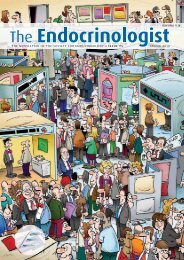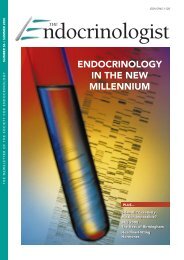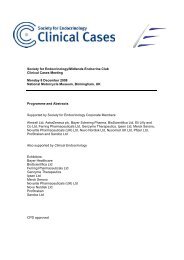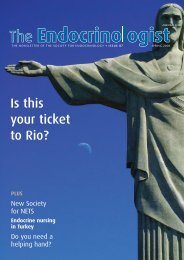Standards for undergraduate medical education - Society for ...
Standards for undergraduate medical education - Society for ...
Standards for undergraduate medical education - Society for ...
Create successful ePaper yourself
Turn your PDF publications into a flip-book with our unique Google optimized e-Paper software.
all the hospital cortisols!’ Liddle tried to<br />
persuade him to stay in the USA, but<br />
Mike was set to return to Barts.<br />
At that time, everyone thought that<br />
prolactin did not exist in man, the<br />
lactogenic pituitary factor being GH<br />
but, whilst in the USA, Mike had<br />
become convinced that, because<br />
galactorrhoea could be present in<br />
patients with pituitary tumours without<br />
acromegaly, prolactin must exist in the<br />
human pituitary. On his return to Barts<br />
he told Landon, ‘We have got to get<br />
into prolactin!’<br />
Prolactin, serendipity and more<br />
It was at a serendipitous coffee break at<br />
a scientific meeting that Mike met Isabel Forsyth of the<br />
Dairy Research Institute who, it transpired during the<br />
conversation, could bio-assay prolactin. Their fruitful<br />
collaboration led to the demonstration that prolactin did<br />
indeed exist in humans. With prolactin on the map, Mike<br />
was approached by the drug company Sandoz, who had<br />
anticipated the discovery of human prolactin, and had<br />
developed a compound that lowered prolactin in rats and<br />
stopped nursing mothers lactating. He agreed to<br />
investigate it.<br />
Mike decided to try the drug on a male patient with a 3-<br />
year history of hypogonadism, galactorrhoea and an<br />
extremely high prolactin level. ‘At day 3 the milk stopped<br />
and we celebrated, by day 7 he got an erection and we all<br />
got excited!’ Prolactin fell precipitately but it took 6<br />
months <strong>for</strong> the assay results to come back. A group of<br />
similar male and female patients were then treated with<br />
dramatic reversal of their hypogonadism and<br />
galactorrhoea.<br />
While at a meeting in the USA, Mike discovered a rival<br />
group working on the same compound, although without<br />
a prolactin assay. Sensing the urgency to publish, he<br />
phoned his registrar Chris Edwards and asked him to write<br />
the paper immediately. The definitive paper on the effects<br />
of bromocriptine on serum prolactin was duly published in<br />
the BMJ within 10 days of Besser’s request!<br />
Coworkers and collaborations<br />
Mike mentions with pride his many talented trainees who<br />
have become big hitters in endocrinology. Mike Thorner,<br />
now a leading US endocrinologist, had a shocking start on<br />
the wards; ‘It was carnage ... all the patients kept falling<br />
over and breaking their noses.’ Thorner had unwittingly<br />
shown that excessive doses of dopamine agonists could<br />
cause postural hypotension. He would, however, go on to<br />
show the key role of dopamine in the hypophysis, and that<br />
dopamine agonists could be used in the treatment of<br />
acromegaly.<br />
Another important collaboration was with Reg Hall,<br />
demonstrating that TRH caused TSH and prolactin release,<br />
as well as studying the actions of a novel peptide called GHrelease<br />
inhibiting hormone, later known as somatostatin.<br />
Per<strong>for</strong>ming insulin tolerance tests followed by TRH<br />
administration to themselves, they<br />
found that it not only inhibited GH but<br />
TSH as well, and with Steve Bloom’s<br />
help at the Hammersmith they found<br />
to their surprise that it also inhibited<br />
many pancreatic and gut peptides.<br />
Being impressed by the properties of<br />
this substance but disappointed by its<br />
short-lasting action, Mike visited the<br />
Barts pharmacy late one night to look<br />
up how long-acting analogues of<br />
insulin were made, and created an<br />
embryonic protamine-zinc precursor<br />
to the now routinely used<br />
somatostatin analogues. The first<br />
human studies with GnRH were also<br />
done with Reg Hall.<br />
As our interview time runs out, we hasten through other<br />
areas of his work, including Davi Cunnah and Chris<br />
Edward’s seminal data on desmopressin, which at the time<br />
was a new revolutionary treatment <strong>for</strong> cranial diabetes<br />
insipidus, the work of Vicky Clement Jones on endorphins,<br />
Ashley Grossman’s work on the neuroendocrine effects of<br />
opiates, John Wass’s studies on acromegaly, the early studies<br />
of GH replacement in hypopituitary patients, and the in vitro<br />
studies on pituitary cell function, to name but a few.<br />
And finally, the future...<br />
We finish the interview with a discussion of the future of<br />
endocrinology and the specialty’s unanswered questions.<br />
Mike tells me that his initial thoughts on molecular biology<br />
were that it was ‘just another technique like litmus paper’.<br />
However, he concedes that the post-genomic era is an<br />
exciting time <strong>for</strong> new post-receptor scientific discoveries.<br />
At the age of 75, he continues to see patients, which he<br />
considers ‘a privilege’, and attends weekly Barts meetings,<br />
having been amused if irritated that post-retirement he<br />
was initially teasingly offered an armchair and served cups<br />
of tea, just as was done to Medvei in his dotage. We<br />
discuss the huge differences between his generation and<br />
today’s NHS, and he reiterates his continued commitment<br />
to UK medicine, and his pride that every penny of private<br />
income during his time at Barts was channelled back into<br />
his research group.<br />
As we part, the imposing figure of Mike Besser pays <strong>for</strong> our<br />
lunch and returns to his clinical commitments, having taken<br />
a couple of urgent calls during our chat. And I return home<br />
having learnt a great deal about the man who has arguably<br />
contributed more towards the clinical development of our<br />
subject than anyone else of his generation.<br />
If you enjoyed this interview, a profile series of<br />
other notable endocrinologists has just started<br />
in Endocrine-Related Cancer. The first profile,<br />
‘Chaos theory and a career in medicine’,<br />
by Marc Lippman is available free at<br />
http://erc.endocrinology-journals.org/<br />
content/19/1/P1.full<br />
MILES LEVY<br />
FEATURES<br />
T H E E N D O C R I N O L O G I S T • I S S U E 1 0 3 • S P R I N G 2 0 1 2<br />
15



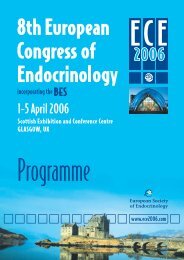
![The Endocrinologist | Issue 99 [PDF] - Society for Endocrinology](https://img.yumpu.com/48213777/1/184x260/the-endocrinologist-issue-99-pdf-society-for-endocrinology.jpg?quality=85)

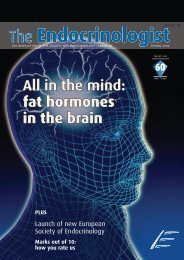
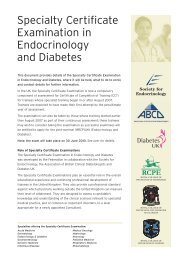
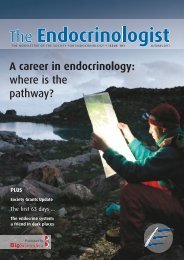
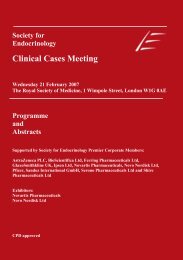

![The Endocrinologist | Issue 97 [PDF] - Society for Endocrinology](https://img.yumpu.com/40840065/1/184x260/the-endocrinologist-issue-97-pdf-society-for-endocrinology.jpg?quality=85)
